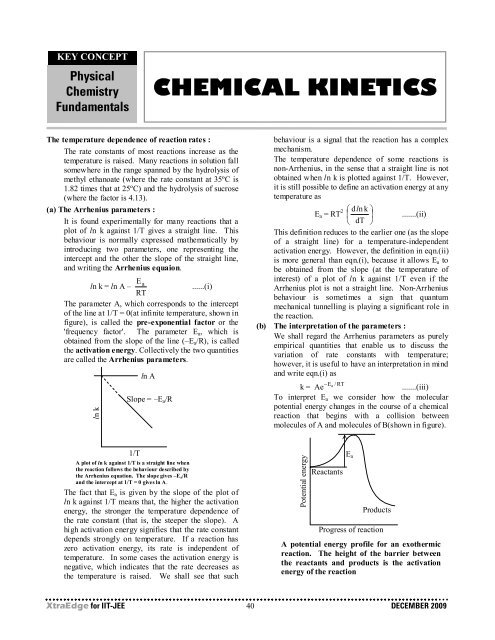You also want an ePaper? Increase the reach of your titles
YUMPU automatically turns print PDFs into web optimized ePapers that Google loves.
KEY CONCEPT<br />
Physical<br />
Chemistry<br />
Fundamentals<br />
CHEMICAL KINETICS<br />
The temperature dependence of reaction rates :<br />
The rate constants of most reactions increase as the<br />
temperature is raised. Many reactions in solution fall<br />
somewhere in the range spanned by the hydrolysis of<br />
methyl ethanoate (where the rate constant at 35ºC is<br />
1.82 times that at 25ºC) and the hydrolysis of sucrose<br />
(where the factor is 4.13).<br />
(a) The Arrhenius parameters :<br />
It is found experimentally for many reactions that a<br />
plot of ln k against 1/T gives a straight line. This<br />
behaviour is normally expressed mathematically by<br />
introducing two parameters, one representing the<br />
intercept and the other the slope of the straight line,<br />
and writing the Arrhenius equaion.<br />
E<br />
ln k = ln A – a<br />
......(i)<br />
RT<br />
The parameter A, which corresponds to the intercept<br />
of the line at 1/T = 0(at infinite temperature, shown in<br />
figure), is called the pre-exponential factor or the<br />
'frequency factor'. The parameter E a , which is<br />
obtained from the slope of the line (–E a /R), is called<br />
the activation energy. Collectively the two quantities<br />
are called the Arrhenius parameters.<br />
ln k<br />
ln A<br />
Slope = –E a /R<br />
behaviour is a signal that the reaction has a complex<br />
mechanism.<br />
The temperature dependence of some reactions is<br />
non-Arrhenius, in the sense that a straight line is not<br />
obtained when ln k is plotted against 1/T. However,<br />
it is still possible to define an activation energy at any<br />
temperature as<br />
E a = RT 2 ⎛ dln k ⎞<br />
⎜ ⎟ .......(ii)<br />
⎝ dT ⎠<br />
This definition reduces to the earlier one (as the slope<br />
of a straight line) for a temperature-independent<br />
activation energy. However, the definition in eqn.(ii)<br />
is more general than eqn.(i), because it allows E a to<br />
be obtained from the slope (at the temperature of<br />
interest) of a plot of ln k against 1/T even if the<br />
Arrhenius plot is not a straight line. Non-Arrhenius<br />
behaviour is sometimes a sign that quantum<br />
mechanical tunnelling is playing a significant role in<br />
the reaction.<br />
(b) The interpretation of the parameters :<br />
We shall regard the Arrhenius parameters as purely<br />
empirical quantities that enable us to discuss the<br />
variation of rate constants with temperature;<br />
however, it is useful to have an interpretation in mind<br />
and write eqn.(i) as<br />
E / RT<br />
k = Ae − a<br />
.......(iii)<br />
To interpret E a we consider how the molecular<br />
potential energy changes in the course of a chemical<br />
reaction that begins with a collision between<br />
molecules of A and molecules of B(shown in figure).<br />
1/T<br />
A plot of ln k against 1/T is a straight line when<br />
the reaction follows the behaviour described by<br />
the Arrhenius equation. The slope gives –E a /R<br />
and the intercept at 1/T = 0 gives ln A.<br />
The fact that E a is given by the slope of the plot of<br />
ln k against 1/T means that, the higher the activation<br />
energy, the stronger the temperature dependence of<br />
the rate constant (that is, the steeper the slope). A<br />
high activation energy signifies that the rate constant<br />
depends strongly on temperature. If a reaction has<br />
zero activation energy, its rate is independent of<br />
temperature. In some cases the activation energy is<br />
negative, which indicates that the rate decreases as<br />
the temperature is raised. We shall see that such<br />
Potential energy<br />
Reactants<br />
E a<br />
Products<br />
Progress of reaction<br />
A potential energy profile for an exothermic<br />
reaction. The height of the barrier between<br />
the reactants and products is the activation<br />
energy of the reaction<br />
XtraEdge for <strong>IIT</strong>-<strong>JEE</strong> 40 DECEMBER 2009

















